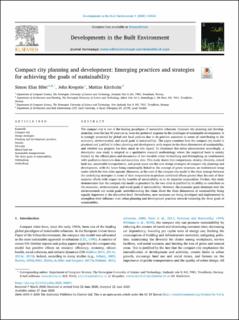| dc.description.abstract | The compact city is one of the leading paradigms of sustainable urbanism. Compact city planning and development has, over the last 30 years or so, been the preferred response to the challenges of sustainable development. It is strongly promoted by global and local policies due to its positive outcomes in terms of contributing to the economic, environmental, and social goals of sustainability. This paper examines how the compact city model is practiced and justified in urban planning and development with respect to the three dimensions of sustainability, and whether any progress has been made in this regard. To illuminate this urban phenomenon accordingly, a descriptive case study is adopted as a qualitative research methodology where the empirical basis is mainly formed by the official plans and documents of two Swedish cities: Gothenburg and Helsingborg, in combination with qualitative interview data and secondary data. This study shows that compactness, density, diversity, mixed land use, sustainable transportation, and green space are the core design strategies of compact city planning and development, with the latter being contextually linked to the concept of green structure, an institutional setup under which the two cities operate. Moreover, at the core of the compact city model is the clear synergy between the underlying strategies in terms of their cooperation to produce combined effects greater than the sum of their separate effects with respect to the benefits of sustainability as to its tripartite composition. Further, this study demonstrates that the compact city model as practiced by the two cities is justified by its ability to contribute to the economic, environmental, and social goals of sustainability. However, the economic goals dominate over the environmental and social goals, notwithstanding the claim about the three dimensions of sustainability being equally important at the discursive level. Nevertheless, new measures are being developed and implemented to strengthen their influence over urban planning and development practices towards balancing the three goals of sustainability. | en_US |

